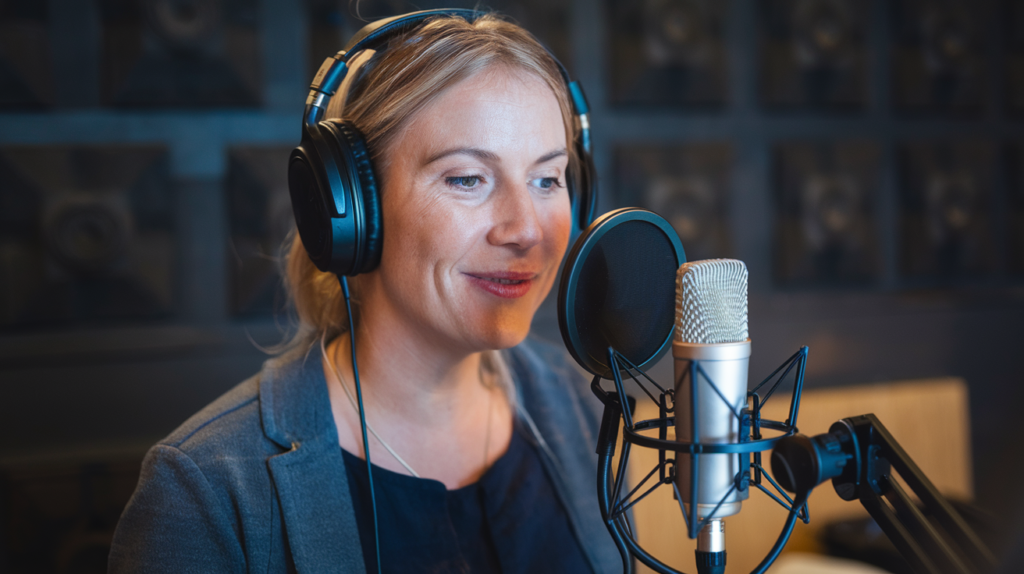Key Takeaways
- Lip-Sync Accuracy is Essential: Ensuring lip-sync accuracy in Māori dubbing significantly enhances viewer immersion and overall film quality, making it a critical focus for filmmakers.
- Cultural Representation Matters: Authentic representation through precise lip-syncing reinforces cultural identities, allowing characters to resonate more deeply with audiences.
- Collaboration is Key: Effective collaboration among directors, voice actors, and translators is vital for achieving seamless dialogue synchronization and maintaining cultural integrity.
- Address Linguistic Challenges: Understanding the unique linguistic structure of Māori helps voice actors adapt scripts appropriately while preserving the original message’s essence.
- Utilize Technology Wisely: Leveraging software solutions for audio editing can streamline the dubbing process, but manual adjustments during recording remain crucial for achieving natural performances.
- Learn from Case Studies: Successful Māori dubbing projects demonstrate that regular communication and contextual adaptation lead to immersive viewer experiences and culturally relevant storytelling.
Ever wondered how to ensure lip-sync accuracy in Māori dubbing? It’s a challenge that can make or break the viewer’s experience. When the dialogue doesn’t match the characters’ mouth movements, it pulls you right out of the story and disrupts immersion.
In a world where authentic representation matters more than ever, getting this right is crucial. Whether you’re a filmmaker, translator, or voice actor, understanding the intricacies of lip-syncing in Māori dubbing can elevate your project to new heights. Let’s dive into strategies that not only enhance accuracy but also respect cultural nuances—because every frame counts when telling a story.
Importance Of Lip-Sync Accuracy
Lip-sync accuracy plays a crucial role in Māori dubbing, deeply influencing the overall quality of the film. Mismatched dialogue and mouth movements disrupt viewer immersion, making it vital for filmmakers to prioritize this aspect.
Cultural Significance
Cultural significance underscores the need for precise lip-syncing in Māori dubbing. Authentic representation ensures that characters resonate with viewers on a deeper level. When voice actors deliver lines that align with visual cues, it reinforces cultural identities and fosters respect for the language. This alignment not only honors Māori culture but also enhances storytelling by creating believable interactions among characters.
Viewer Experience
Viewer experience hinges on seamless lip-syncing during films or shows. An accurately synced performance keeps audiences engaged and emotionally invested in the narrative. Discrepancies between spoken words and visual actions can cause distractions, pulling viewers away from the story being told. Effective collaboration among directors, voice actors, and translators is essential to achieving this balance, ensuring every detail matters for an immersive viewing experience.
Challenges In Maori Dubbing
Māori dubbing presents unique challenges that require careful navigation to ensure authenticity and viewer engagement.
Linguistic Differences
Linguistic differences pose significant hurdles in Māori dubbing. Māori language structure differs from English, particularly in sentence construction and idiomatic expressions. Voice actors must capture the essence of the original dialogue while adapting it to fit the rhythms and nuances of Māori. Mismatches can lead to awkward phrasing or unnatural delivery, which disrupts immersion. Effective communication among translators and voice talent is crucial here; they need to work collaboratively to create scripts that resonate culturally and linguistically with audiences.
Technical Constraints
Technical constraints further complicate the dubbing process. Timing plays a vital role in achieving lip-sync accuracy, as dialogue must align closely with animated mouth movements. Voice artists often face limitations due to pre-existing animation timing, making it difficult to maintain natural speech patterns within these confines. Additionally, audio quality impacts performance; background noise or poor recording conditions can detract from vocal clarity, affecting overall viewer experience. Navigating these technical aspects requires skilled coordination between directors, sound engineers, and voice actors for optimal results.
Best Practices For Ensuring Lip-Sync Accuracy In Maori Dubbing
Achieving lip-sync accuracy in Māori dubbing requires a thoughtful approach that respects both the language and the cultural nuances. Focus on these best practices to enhance your dubbing projects.
Contextual Adaptation
Contextual adaptation plays a crucial role in ensuring that dialogue aligns with character movements. Each phrase needs careful consideration to match mouth shapes and timing naturally. When adapting scripts, prioritize phrases that reflect the original meaning while fitting seamlessly into the lip movements of characters. Use local idioms or expressions where appropriate, as they can enrich authenticity and maintain viewer engagement.
Collaboration With Native Speakers
Collaboration with native speakers enhances quality in Māori dubbing projects. Engage voice talent who are fluent in Māori; their insights can significantly improve script accuracy and emotional resonance. They understand linguistic subtleties essential for maintaining cultural integrity, ensuring that voiceovers sound natural and relatable. Regular feedback from these language experts during recording sessions helps refine performances, leading to more immersive viewing experiences.
Remember, effective communication among directors, translators, and voice actors is key to navigating the challenges inherent in Māori dubbing. By focusing on contextual adaptation and collaborating closely with native speakers, you enhance not only lip-sync accuracy but also overall audience connection with the material.
Tools And Techniques
Achieving lip-sync accuracy in Māori dubbing requires a blend of software solutions and manual adjustments. Utilizing the right tools ensures that voice actors’ performances align seamlessly with animated mouth movements, enhancing viewer immersion.
Software Solutions
Several software applications specialize in audio editing and dubbing, making it easier to synchronize dialogue with visuals. Programs like Adobe Audition or Avid Pro Tools allow you to manipulate audio tracks precisely, ensuring that timing aligns with on-screen actions. These platforms often feature visual waveforms that help identify moments where dialogue overlaps with critical visual cues, allowing for more accurate adjustments.
Additionally, specialized lip-sync software can analyze phonetic sounds and suggest timings for voiceovers automatically. This technology streamlines the process by predicting mouth shapes based on spoken words, which significantly improves efficiency while maintaining cultural authenticity in the script.
Manual Adjustments
While software provides invaluable assistance, manual adjustments play an equally important role in perfecting lip sync. Voice actors must pay close attention to their performances during recording sessions. They should adjust their pacing and inflection to match character emotions while considering how each line fits visually.
Directors or sound engineers can also make real-time tweaks during recording sessions. Encouraging open communication among team members fosters an environment where immediate feedback enhances performance quality. If a certain phrase doesn’t align perfectly with mouth movements after initial recordings, re-recording specific lines allows voice talent to refine delivery for better synchronization.
Incorporating native speakers into this process adds another layer of authenticity and cultural relevance. Their insights ensure scripts resonate deeply while helping voice actors capture the unique rhythm of the Māori language—integral for achieving compelling performances that connect emotionally with audiences.
Combining these tools and techniques creates a comprehensive approach towards mastering lip-sync accuracy in Māori dubbing. Each detail contributes significantly to delivering a polished final product that honors both language and culture effectively.
Case Studies
Māori dubbing projects showcase the importance of achieving lip-sync accuracy. Several successful examples demonstrate effective strategies and techniques in this realm.
Successful Māori Dubbing Projects
One notable project involved a popular animated series that embraced cultural narratives while ensuring accurate lip-syncing. The team collaborated closely with local voice actors, using their insights to adapt scripts authentically. This collaboration not only enhanced authenticity but also helped the voice talent connect emotionally with their roles, resulting in engaging performances that resonated with viewers.
Another successful instance comes from a feature film adaptation where seamless blending of dialogue and visuals was paramount. The production utilized specialized software for phonetic analysis, allowing voice artists to match speech patterns precisely to character movements. Combined with regular feedback sessions from native speakers, this approach refined the script’s emotional tone and cultural relevance.
Lessons Learned
Important lessons emerge from these case studies, emphasizing the need for collaboration among all parties involved. Regular communication between directors, translators, and voice actors fosters understanding and alignment on creative visions. When everyone shares an objective—to create an immersive viewer experience—outcomes improve significantly.
Furthermore, adapting scripts contextually is crucial. Each phrase should align naturally with mouth shapes while reflecting Māori culture accurately. Utilizing local idioms can enhance authenticity and engage audiences more deeply.
Finally, investing time in practicing timing during recording sessions pays off immensely. Voice talent who rehearse together often achieve better synchronization results on-screen as they become familiar with each other’s pacing and delivery styles.
These case studies highlight how meticulous attention to detail can elevate Māori dubbing projects to new heights while respecting cultural nuances effectively.
Conclusion
Achieving lip-sync accuracy in Māori dubbing is vital for creating an immersive viewing experience. Every detail matters as it impacts cultural representation and emotional engagement. By fostering collaboration among directors, voice actors, and translators you can navigate the unique challenges of this process.
Utilizing tools like specialized software alongside manual adjustments enhances precision and authenticity. Engaging native speakers ensures scripts resonate culturally while maintaining alignment with visual elements. This meticulous approach not only elevates the quality of your project but also honors the rich heritage of the Māori language.
With dedication to these practices you’ll contribute to a more authentic storytelling experience that resonates deeply with audiences.
Frequently Asked Questions
What is lip-sync accuracy in Māori dubbing?
Lip-sync accuracy in Māori dubbing refers to the precise alignment of spoken dialogue with the mouth movements of animated characters. This ensures that viewers remain engaged and immersed in the story without distractions caused by mismatched speech and visuals.
Why is authentic representation important in filmmaking?
Authentic representation is essential because it respects cultural identities and provides accurate portrayals of diverse communities. By ensuring that voices reflect their true culture, filmmakers create a deeper connection between characters and audiences, enhancing overall viewer experience.
What challenges are faced in Māori dubbing?
Māori dubbing encounters unique challenges like linguistic differences from English, technical constraints affecting timing, and the need for culturally resonant scripts. These factors require careful adaptation to maintain authenticity while achieving synchronization with character movements.
How can lip-sync accuracy be improved?
Improving lip-sync accuracy involves careful contextual adaptation of phrases, collaboration with native speakers for script refinement, and regular feedback during recording sessions. This approach helps ensure that dialogue matches mouth shapes naturally while preserving cultural integrity.
What tools are used for achieving lip-sync accuracy?
Tools include audio editing programs like Adobe Audition and Avid Pro Tools for synchronization, as well as specialized software that analyzes phonetic sounds. Manual adjustments by voice actors also play a crucial role in aligning performances with visual cues effectively.
How does collaboration enhance the dubbing process?
Collaboration among directors, translators, sound engineers, and voice actors is vital to achieving seamless lip-syncing. Effective communication allows all parties to share insights and make necessary adjustments during production to create an immersive viewing experience.
Can you provide examples of successful Māori dubbing projects?
Yes! Successful projects include a popular animated series where local voice actors collaborated closely on cultural narratives. Another example is a feature film using specialized software for phonetic analysis to match speech patterns accurately with character movements.







